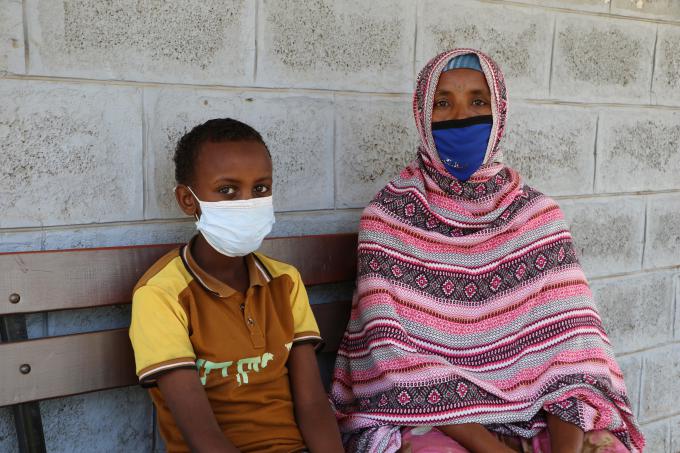I do not want my children to go through what I went through : Kimia
In 2018, Kimia Oumer(35), a mother of five (two girls and three boys), had to flee Jigjiga, her hometown, with her children, escaping the ethnic violence in the area. Kimia and her husband with five of their children live in a temporary camp for Internally Displaced People (IDPs) at Adama town where more than 5,000 internally displaced people reside, most of them children and women struggling to sustain life in a confined compartment built with corrugated iron sheet. She and her family are currently dependent on the cash assistance provided by Save the Children though the emergency cash provision project for households impacted by the Coronavirus pandemic in six major cities in Ethiopia including Adama city.
Kimia’s story in her own words
Before we came here, we lived in a place called Jigjiga, which is located in the Somali Region, Ethiopia. We lived there for more than 14 years. Three years ago, my husband and I ran away from the violence, carrying five of our children. We first walked for more than two days and nights through the forest and the scorching sun to get to Chinaksen town in Oromia Region. On the day of the conflict, we all were dispersed and ran for our lives in different directions. It was two days later that we met at the Adults training centre in Chinaksen town. After staying for six months there, we finally were brought here to Adama. We left our home empty handed, only with the clothes we were wearing at the time”.
We lost all our belongings and our house was burnt to the ground because of the conflict. Before the conflict happened, I used to run a small shop in the area and earned good income and I was able to support my family. We are now in a helpless situation.
Until very recently my understanding about the Coronavirus was very low. The first time I heard about the disease was from my neighbors. When I first heard about the new virus, I was shocked and could not believe it. Later, however, we were fully informed and become aware of the disease after we were given continuous education and information on the disease transmission, and its prevention methods through a campaign and from media.
With the regular education that we were provided, we have gained a better understanding and awareness on the disease and how to prevent it, so now we can protect our families, our neighbors and ourselves. What worries me a little right now is that the reluctance of some people may cost us lives in the future.
The Coronavirus has caused us many problems. Just to mention a few of these, it disrupted our children’s education, many people have not been able to get out and work and it has caused a lot of stress on their lives.
Since we came here, we have been living on a small food assistance from government. However, this support discontinued six months ago and we are currently living with the financial support that we receive from Save the Children. With the cash that we have been provided, we were able to provide enough food to our children.
We wish if we could be provided with a financial grant for us to be able to engage in income-generating activities that could enable us earn a sustainable income and improve our livelihood. I want my children to excel academically and be able to support themselves and me. I do not want to see my children go through what I went through.
What save the children is doing in response to the coronavirus pandemic
With the funding support from KOICA, Save the Children through its emergency health response project and in collaboration with different government line offices has been providing a series of awareness-raising sessions on how to prevent the spread of the Coronavirus using local Media and mobile campaigns.
To date, we have been able to prepare and deliver a series of educational messages on the virus s to more than 8,700 people (of which 4,300 were internally displaced people living in IDP camps) using loudspeakers installed on a car. In addition, more than 5,000 leaflets with messages around the transmission and prevention methods of the disease that was prepared in the local language have been distributed to the local people.
 Ethiopia
Ethiopia 